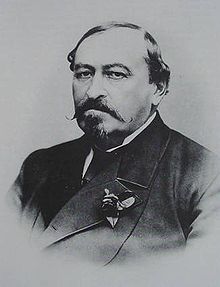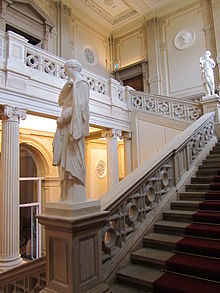This is an old revision of this page, as edited by MaybeItsBecauseImALondoner (talk | contribs) at 11:25, 18 December 2024. The present address (URL) is a permanent link to this revision, which may differ significantly from the current revision.
Revision as of 11:25, 18 December 2024 by MaybeItsBecauseImALondoner (talk | contribs)(diff) ← Previous revision | Latest revision (diff) | Newer revision → (diff)
The Ducal Museum Gotha (German - Herzogliche Museum Gotha) is a museum in the German city of Gotha, located in the Schlosspark to the south of the Schloss Friedenstein. Its collection was the art collection of the former Duchy of Saxe-Gotha, consisting of Egyptian and Greco-Roman antiquities, Renaissance paintings such as The Gotha Couple, Chinese and Japanese art, and sculptures from various eras.
Reopening in 2013, it is housed in a 19th century Neorenaissance building owned by the city, whilst the museum itself is managed by the Friedenstein Castle Gotha Foundation, founded in 2004. Martin Eberle has been the Foundation's director since 2007.
History

19th century
1945-present
At the end of the Second World War, the collections of the Ducal Museum were heavily affected by looting before the Soviets' arrival. What was left of the art collection was taken to the USSR and only returned to the city in 1956, after which they were housed in the Friedenstein Palace.
The remaining parts of the art collections were transported to the Soviet Union in 1945 and housed in Friedenstein Castle after their return in 1956. The natural science collections remained in the building which had previously also housed the Ducal Museum and were expanded to include the holdings of the Natural History Museum. After the building was remodeled, the Central Biological Museum was opened in the former Ducal Museum on 1 August 1954. The largest natural history museum in Thuringia at the time, it was later renamed the Naturkundemuseum (Natural History Museum) and then in 1971 it was the Museum der Natur Gotha (Museum of Nature Gotha).
21st century
List of directors
Museums
- Carl Aldenhoven (1879–1890)
- Karl Purgold (1890–1934)
- Eberhard Schenk zu Schweinsberg (1934–1946)
- Bruno Voigt (1946–1954)
- Michel Hebecker (1986–1992)
- Rudolf Funk (1992)
- Klaus Roewer (1995–1997)
- Elisabeth Dobritzsch and Ulrich Mahlau (1997–1998)
- Klaus Roewer (1998–1999)
- Rainer Samietz and Ulrich Mahlau (1999–2001)
Foundation
- Katharina Bechler (2004–2006)
- Ulrich Mahlau (2006–2007)
- Martin Eberle (2007–2018)
- Tobias Pfeifer-Helke (2019-)
Displays
The basement displays show ancient Greek, Roman and Egyptian art and 18th century Italian cork models of buildings from those civilizations. Sculptures and temporary exhibitions are housed on the ground floor, whilst the first floor houses paintings (such as Dutch Renaissance works and ones by Lucas Cranach the Elder), Chinese porcelain, Japanese lacquerware and other East Asian art.
-
Fragment of a sarcophagus from Attica, 3rd century AD
-
The Gotha Couple, 1480
-
 Cranach the Elder, Christ and Mary Magdalene, 1516–20
Cranach the Elder, Christ and Mary Magdalene, 1516–20
-
 Cranach the Elder, Law and Grace, 1529
Cranach the Elder, Law and Grace, 1529
-
Gotha Altarpiece, 1540
-
 Caspar David Friedrich, Cross in the Mountains, 1823
Caspar David Friedrich, Cross in the Mountains, 1823
-
Bronze miniature copy of the Farnese Bull by Adriaen de Vries, 1614
-
 Abraham de Vries, Portrait of an Unknown Man, 1643
Abraham de Vries, Portrait of an Unknown Man, 1643
-
Geniuses of Concord and Harmony, China, c. 1700
-
Yixing teapots, 18th century
-
Cork model of the Temple of Portunus, 18th century
-
Cork model of the Arch of Constantine, 18th century
Architecture


The building is mainly made up of Seeberg sandstone, with some stone from Pirna in Saxony. Franz von Neumann based his designs on existing museum buildings built between 1800 and 1850, but did also introduce ideas of his own, which in turn became ground-breaking for later buildings. The Palace of Versailles was the main influence on the facade.
The complex is centred on a glass dome over a central octagon (housing a life-size 1882 Christian Behrens statue of Ernst II wearing the robes of a Knight of the Order of the Garter) and the main entrance (with two seated lions on the main staircase by sculptor Franz Melnitzky and two allegorical sandstone statues in the entrance hall), whilst its corners are designed like pavilions. On the corners of the attic are groups of figures symbolizing art and science.
Inside, the path to the halls and cabinets leads through a magnificent, very clearly structured vestibule. Italian marble and a multi-coloured stone mosaic determine the room's overall appearance. In the basement are a series of small cabinets, whilst on the ground floor there are two spacious, light-flooded halls supported by pillars and on the upper floor are halls with skylights filled with cabinets.
Bibliography
- (in German) Martin Eberle: Herzogliches Museum Gotha. Münzkabinett, Kupferstichkabinett, Ostasiatika. Mitteldeutscher Verlag, Halle (Saale) 2013, ISBN 978-3-95462-017-3.
- (in German) Stiftung Schloss Friedenstein Gotha (Hrsg.): Museen der Stiftung Schloss Friedenstein Gotha: Schlossmuseum, Museum der Natur, Museum für Regionalgeschichte und Volkskunde. Deutscher Kunstverlag, München/Berlin 2007, ISBN 978-3-422-06620-5.
- (in German) Wolfgang Zimmermann: Der Bau des Herzoglichen Museums zu Gotha (1864–1879). In: Harald Bachmann, Wener Korn, Helmut Claus, Elisabeth Dobritzsch (ed.s): Herzog Ernst II. von Sachsen-Coburg und Gotha, 1818–1893 und seine Zeit, Jubiläumsschrift im Auftrag der Städte Coburg und Goth. Maro Verlag, Augsburg 1993, ISBN 3-87512-198-8, S. 249–261.
External links
- (in German) Herzogliches Museums Gotha. In: StiftungFriedenstein.de
- (in German) Herzogliches Museums Gotha. In: Museen.Thueringen.de
- (in German) Herzogliches Museums Gotha. In: Museum.de
- (in German) Website des Freundeskreises Kunstsammlungen Schloss Friedenstein Gotha e. V.
References
- (in German) Homepage mitteldeutscher verlag
50°56′36″N 10°42′21″E / 50.94333°N 10.70583°E / 50.94333; 10.70583
Categories: